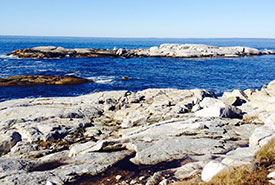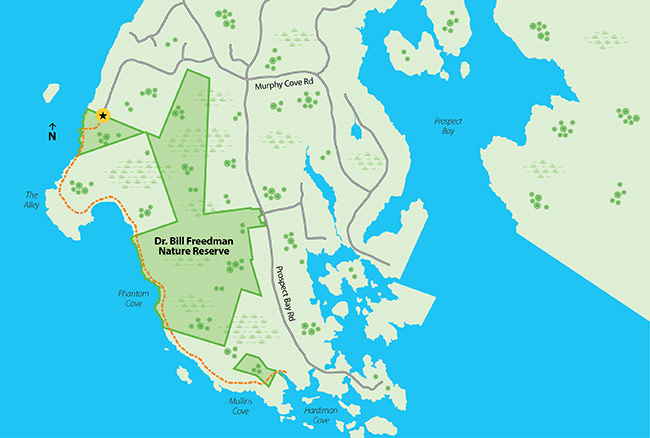Dr. Bill Freedman Nature Reserve

Rocks and ocean as seen on the Dr. Bill Freedman Nature Reserve (Photo by NCC)
A majestic coastal landscape that includes eight types of habitat
Dr. Bill Freedman was an ecologist and former Chair of the Department of Biology at Dalhousie University, where he also served as professor emeritus. He was also a major figure with the Nature Conservancy of Canada (NCC) as a board member and volunteer for more than 25 years. Dr. Bill, as he was affectionately known, passed away in 2015. The Dr. Bill Freedman Nature Reserve is dedicated to his memory and his contributions to NCC.
The reserve is located just 23 kilometres southwest of Halifax, Nova Scotia. The coastal barrens landscape juts out into the Atlantic Ocean and is flanked by picturesque Shad Bay and Prospect Bay. Natural features include eight types of habitat: white spruce coastal forest, old fields, bogs, granite barrens, boulder/cobble shoreline, rocky shoreline, cliffs and open ocean.

Dr. Bill Freedman Nature Reserve, NS (Graphic by Jacques Perrault)
Legend
- - High Head Trail
★ Trailhead
- balsam fir
- crowberry
- harlequin duck
- mountain holly
- red maple
- ruffed grouse
- snowshoe hare
- speckled alder
- white birch
- white-tailed deer
- wild raisin
The popular 7.6-kilometre (round-trip) High Head Trail passes through four sections of NCC’s 133-hectare nature reserve. This moderately challenging trail winds in and out of forested pathways onto rocky outcrops, which provide breathtaking
views of the open ocean. Nova Scotia’s jagged southern coastline and several rocky islands can be seen in the distance.
The granite barrens found here purify massive amounts of ground water prior to its re-entry into the ocean. With its fresh sea breezes and panoramic vistas, the High Head Trail is a wonderful hike in the summertime and an ideal place for birdwatching.
Stay safe
On your journey, it is important to leave no trace behind and to stay on the well-travelled path outlining the coast. It is advised not to venture inland toward sensitive ecological habitat nor too close to the rocky cliffs.
This story originally appeared in the summer 2022 issue of the Nature Conservancy of Canada Magazine.
Explore additional content from our summer issue here >
The Nature Conservancy of Canada Magazine is distributed to NCC donors and supporters who contribute $100 or more per year.




